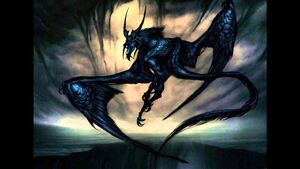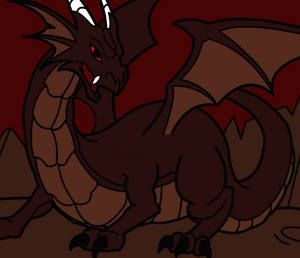Dragons are very popular antagonists in folklore, mythology and fairytales, though it is worth noting this tends to only apply to Western cultures, as other cultures (such as China) had a more positive view of dragons (which also spread to the West in time).
Name
The word dragon entered the English language in the early 13th century from Old French dragon, which in turn comes from Latin draconem (nominative draco) meaning "huge serpent, dragon", from the Greek word δράκων, drakon (genitive drakontos, δράκοντος) "serpent, giant seafish". The Greek and Latin term referred to any great serpent, not necessarily mythological, and this usage was also current in English up to the 18th century.
Summary
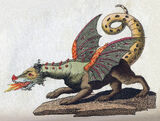
Illustration of a winged, fire-breathing dragon by Friedrich Justin Bertuch from 1806.
Dragons were originally depicted as giant fire-breathing snakes, often with wings and they would stand as the ultimate opponent to a brave knight or ancient hero. One of the most famous examples of this type of story was Saint George and The Dragon, in which the brave knight went forth to slay a fearsome dragon to save a beautiful princess from its terrible grasp, this story became so popular that it has inspired innumerable adaptations in film and literature.
Other examples of dragons as antagonists in fairytales can be found in stories such as Sleeping Beauty, in which the evil fairy transforms herself into a gigantic dragon (a scene made famous by Disney in their adaptation of the fairytale, in which Maleficent's final form is a large black dragon).
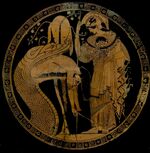
Attic red-figure kylix painting from c. 480–470 BC showing Athena observing as the Colchian dragon disgorges the hero Jason.
Sometimes, a dragon was not a winged reptile but rather a gigantic snake, known as a "Wyrm". These dragons were said to live in water or in wells and they often grew so large that brave heroes were called upon to slay them and save livestock or people from their often immense appetites.
As with many characters in folklore, dragons may have been symbolic, a way of expressing how brave a hero was by having them defeat a seemingly unconquerable foe (in a similar fashion as Giants were often used to symbolize the defeat of bigger enemies, such as military powers or invaders).
Dragons have also been given a malevolent role in the scripture of many religions, especially Christianity, due to their serpentine nature, they are often associated with the Devil and indeed one of the many forms given to the Devil is that of a dragon: he is also said to take the form of a large serpent (as he had done in the Garden of Eden).
Many fairytales and legends also have dragons acting as guardians of large treasures or mystical items, making them popular opponents in fantasy games where heroes have to defeat one or more dragons in order to obtain the items it has been guarding, some stories take the role of guardian even further and have dragons acting as guardians of nature itself.
However, there are stories where dragons are merely wild animals struggling to survive.
Depends on their physical appearance, dragons can be divided into following groups:
- Western Dragons typically depicted as a huge fire-breathing, monstrous, scaly, and horned lizard-like creature, with leathery, bat-like wings, with four legs and a long muscular tail. It is sometimes shown with feathered wings, crests, fiery manes, ivory spikes running down its spine and various exotic colorations. Dragon's blood often has magical properties. The typical dragon protects a cavern or castle filled with gold and treasure and is often associated with a great hero who tries to slay it. Though a winged creature, the dragon is generally to be found in its underground lair, a cave that identifies it as an ancient creature of earth.
- Asian Dragons typically portrayed as long, scaled, serpentine creatures with four legs. Traditionally, they symbolize potent and auspicious powers, particularly control over water, rainfall, hurricane, and floods, and are also a symbols of power, strength, and good luck. They have also extended range of supernatural powers, chancing size or form (most are able to take human shape), fly among the clouds or hide in water, form clouds, turn into water, change color as an ability to blend in with their surroundings as an effective form of camouflage or glow in the dark.
- Lesser Drakes is something of a catch-all category. Typically smaller and more animalistic in mind and behavior, but this not always the case in popular culture:
- Lindworms: Snake-like dragons with only front limbs akin to mole lizards and may or may not have wings.
- Sea Serpents; Lesser Dragons which physiology more fit for underwater adaptation, possessing fins and slender body. Typical bear some resemblance to extinct mosasaurs or crocodiles.
- Wyrms: Snake-like, limbless dragons that grow fast to vast size and are extremely poisonous with ability to regenerate from even being hacked to pieces, as long as the pieces are not too far from each other. Some may have an ability to create or increase treasure large enough for them to lay on.
- Wyverns: Out of variants of lesser dragons, wvyerns are most well-known. Greatly resembles stereotypical Western Dragons in many ways, except for lacking front limbs for their clawed wings actually modified forelegs akin to bats. Such physiology configuration being considered more "realistic" as something that could actually evolve, explaining why many dragons in popular culture (ex. dragons in Harry Potter films, dragons of Reign of Fire and Peter Jackson's take of Smaug) often depicted as wyvern-like but with same size and powers of traditional Western Dragons (fire breath, durable hide, and great intelligence). In mythology, however, wyverns actually dwarved by Western Dragons in size, mostly lacked breath powers, using barbed tail more often, and more animalistic.
South and West Asia
Ancient India
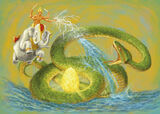
Indra battles Vritra
In the early Vedic religion, Vritra (Sanskrit: वृत्र (Devanāgarī) or Vṛtra (IAST)) "the enveloper", was an Asura and also a "naga" (serpent) (नाग) or possibly dragon-like creature, the personification of drought and enemy of Indra. Vritra was also known in the Vedas as Ahi ("snake") (अहि), and he is said to have had three heads.
In the text Life of Apollonius of Tyana written by Flavius Philostratus, this contains a long detailed description of India heavily infested with dragons. However, this does not correspond with modern Indian belief, and likely not with Indian belief as it was in his time, whether Apollonius invented this story, or whether he believed someone else who told him it.
Ancient Persia
Aži Dahāka is the source of the modern Persian word azhdahā or ezhdehā اژده ها (Middle Persian azdahāg) meaning "dragon", often used of a dragon depicted upon a banner of war. The Persians believed that the baby of a dragon will be the same color as the mother's eyes. In Middle Persian he is called Dahāg or Bēvar-Asp, the latter meaning "[he who has] 10,000 horses". Several other dragons and dragon-like creatures (all of them malevolent) are mentioned in Zoroastrian scripture.
Judaism
In Jewish religious texts, the first mention of a dragon-like creature is in the Biblical works of Job (26:13), and Isaiah (27:1) where it is called Nachash Bare'ach, or a "Pole Serpent". This is identified in the Midrash Rabba to Genesis 1:21 as Leviathan from the word Taninim (תנינים) "and God created the great sea monsters". In modern Hebrew the word Taninim is used for Crocodiles but this is a 20th-century usage unconnected with the original Biblical meaning.
In later Biblical texts, the Book of Isaiah, the Book of Job, and Psalm 89 refer to a sea-demon called Rahab (not to be confused with Rahab, the woman of Jericho mentioned in the Book of Joshua). AB equates this Rahab with a dragon or monster. "Rahab" is the English transliteration of רהב (reb) with the several meanings: pride, a mythical sea-monster, or Egypt (as an emblematic name). In the Douay-Rheims version, translated via Medieval Latin from the Vulgate, the word reb is rendered "the proud one" in DRA and "the power of the sea" in DRA (Psalm 88 is equivalent to Psalm 89 in other versions due to different verse numbering in the Vulgate). The connection between the sea monster and "Leviathan the serpent" is made in KJV.
In Jewish astronomy, this is also identified with the North Pole, the star Thuban which, around 4,500 years ago, was the star in the Draco constellation's "tail". However, this can also have been either the celestial pole or the ecliptic pole. The ancient observers noted that Draco was at the top of the celestial pole, giving the appearance that stars were "hanging" from it, and in Hebrew it is referred to as Teli, from talah (תלה) – to hang. Hebrew writers from Arabic-speaking locations identified the Teli as Al Jaz'har, which is a Persian word for a "knot" or a "node" because of the intersection of the inclination of the orbit of a planet from the elliptic that forms two such nodes. In modern astronomy these are called the ascending node and the descending node, but in medieval astronomy, they were referred to as "dragon's head" and "dragon's tail".
The Merthyr Synagogue features a dragon on the front gable.
Animals that may have inspired Dragons
It has been speculated that accounts of spitting cobras may be the origin of the myths of fire-breathing dragons.
Nile crocodiles (today very restricted in range) were in ancient times occasionally found in Southern Europe, having swum across the Mediterranean. Such wayward crocodiles may have inspired dragon myths. Skeletons of whales, as well as dinosaur and mammalian fossils may have been occasionally mistaken for the bones of dragons and other mythological creatures; for example, a discovery in 300 BC in Wucheng, Sichuan, China, was labeled as such by Chang Qu. Adrienne Mayor has written on the subject of fossils as the inspiration for myths in her book The First Fossil Hunters, which was published in 2000. And in an entry in the Encyclopedia of Geology, she wrote: "Fossil remains generated a variety of geomyths speculating on the creatures' identity and cause of their destruction. Many ancient cultures, from China and India to Greece, America, and Australia, told tales of dragons, monsters, and giant heroes..".
In Australia, stories of such creatures may have referred to the land crocodiles, Quinkana sp., a terrestrial crocodile which grew to 5 to possibly 7 meters long, or the monitor lizard Varanus priscus (formerly Megalania prisca) a giant carnivorous goanna that might have grown to 7 feet, and weighed up to 1,940 lbs, or rainbow serpents (possibly Wonambi naracoortensis) that were part of the extinct megafauna of Australia. Today the Komodo monitor lizard Varanus komodoensis is known in English as the Komodo dragon.
In the 2000 book An Instinct for Dragons, the anthropologist David E. Jones suggests a hypothesis that humans just like monkeys have inherited instinctive reactions to snakes, large cats and birds of prey. Dragons have features that are combinations of these three. An instinctive fear for these three would explain why dragons with similar features occur in stories from independent cultures on all continents.
In Slovenia, Janez Vajkard Valvasor compile folk stories on the Olm, a subterranean salamander, in the late Johann Weikhard von Valvasor's 1689 book The Glory of the Duchy of Carniola. It is mentioned as a baby dragon. Heavy rains of Slovenia would wash the olms up from their subterranean habitat, giving rise to the folklore belief that great dragons lived beneath the Earth's crust, and the olms were the undeveloped offspring of these mythical beasts.
Modern Depictions
In the early 20th century sculpture of the late Norwegian artist Gustav Vigeland, inspired by Medieval art, dragons are a frequent theme — as symbols of sin but also as a nature force, fighting against man.
Dragons and dragon motifs are featured in many works of modern literature, particularly within the fantasy genre. Prominent works depicting dragons include J.R.R. Tolkien's Silmarillion and The Hobbit, J. K. Rowling's Harry Potter novels, Anne McCaffrey's Dragonriders of Pern, George R. R. Martin's series A Song of Ice and Fire, and Christopher Paolini's tetralogy Inheritance Cycle.
The popular roleplaying game system Dungeons & Dragons (D&D) makes heavy use of dragons, and has served as inspiration for many other games' dragons. Though dragons usually serve as adversaries, they can be either good or evil, with their alignment being determined by their species. For example, a red dragon is evil and breathes fire.
Dragons have become more varied, with some heroic and noble dragons appearing (such as Spyro from the titular videogame series Spyro the Dragon or Draco from Dragonheart) and some cruel and malevolent dragons appearing (such as Malefor).
Cartography
There is a widespread belief that earlier cartographers used the Latin phrase hic sunt dracones, i.e., "the dragons are here", or "here are dragons", to denote dangerous or unexplored territories, in imitation of the infrequent medieval practice of putting sea serpents and other mythological creatures in the blank areas of maps. However, the only known use of this exact phrase is in the Latin form "HC SVNT DRACONES" on the Lenox Globe (ca. 1503–1507).
Another map that contains dragons is the one of Bishop Olaus Magnus'. The Carta Marina map of Scandinavia (1539) has many monsters in the northern sea, as well as a winged, bipedal, predatory land animal resembling a dragon in northern Lapland.


